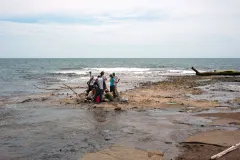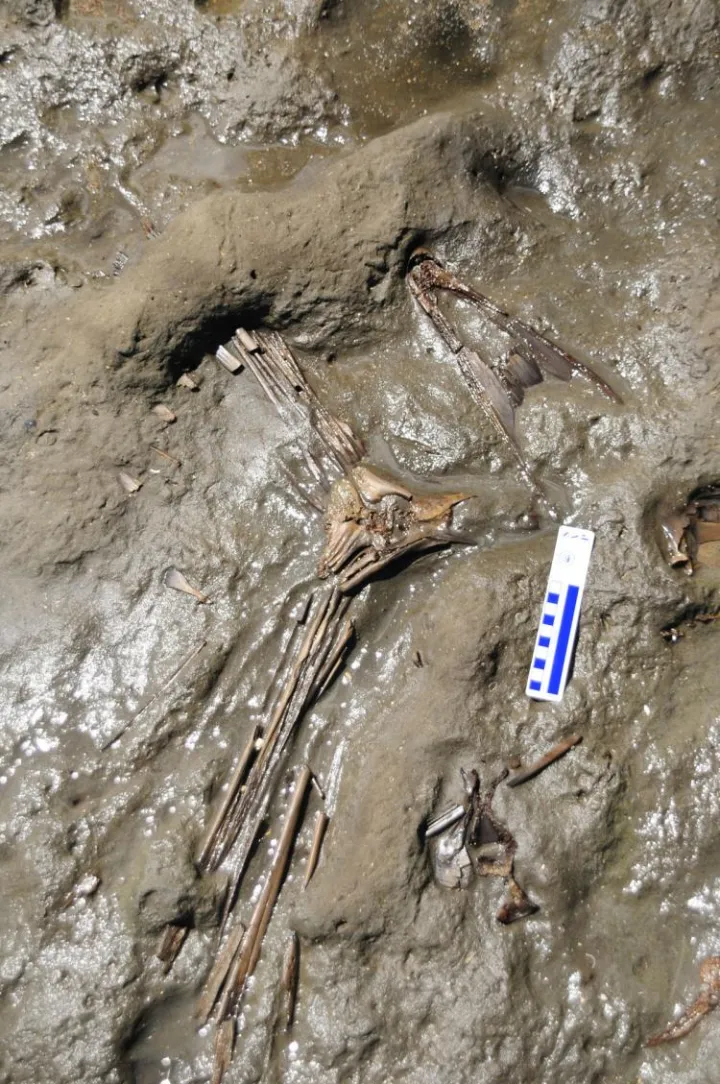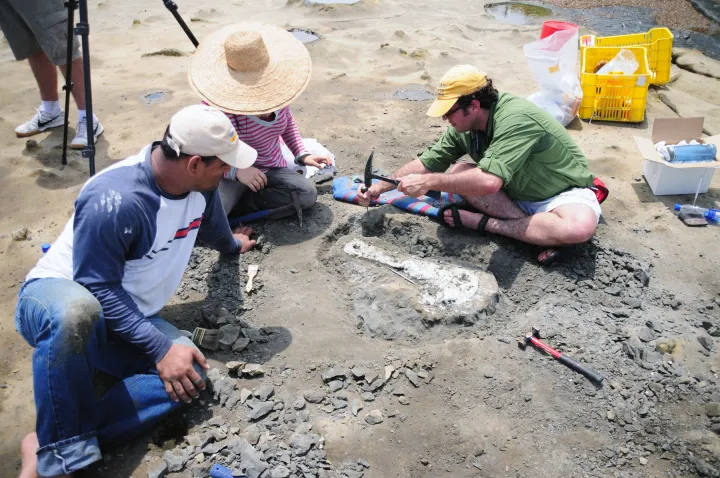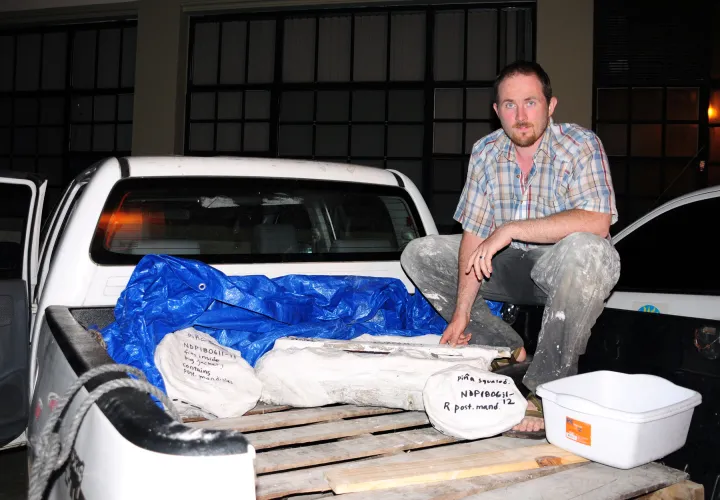Fossil Whale Found, Excavated, Jacketed, and Returned to STRI!

Jorge and I packed up the night we arrived in Panama with Aaron O'Dea and his team from STRI. The road we took in two field vehicles mostly followed the Panama Canal heading northwards; we had to stop at a tanker ship crossing, where the locks separated the roadway. Quite an engineering marvel. We spent the night in Achiote, fell asleep listening to howler monkeys, and awoke to the sights of hummingbirds and more toucans. Before heading out to the fossil locality on the Caribbean coast, we had a wonderful breakfast at a cantina by the side of the road: roasted chicken, plantains and some coffee.
As planned, we arrived at the site, in the town of Piña, just as the high tide was going out. As we ambled out through the surf, we spotted several other interesting fossils along the way: a partial whale skull, deeply lodged in the seacliff and too difficult to extract; shark teeth and bits of fossil wood; and a complete skeleton of a large fish (shown left), probably a close relative to a swordfish or marlin. Even better, the fish skeleton was complete from nose to the tailfin! We estimate that the fish, in life, was probably 10 feet long. Unfortunately, we didn't plan on finding this kind of fossil and we were limited by the amount of time and plaster that we carried with us, so it still remains in the rocks along the beach.
Time and tides were against us, so we had to move relatively quickly. The fossil squalodontid skull was still in relatively decent condition, considering that it's been battered by the surf, exposed to contant weathering from sun, sand and waves. We could see that the skull was preserved bottom-side up, with most of the braincase missing. The snout was still preserved, along with some of its teeth; we also saw hints of the lower jaws nearby. Fossil whale skulls are rarely preserved intact because dead carcasses on the seafloor are scavenged, moved by ocean currents and by wave action.
We set up the Ocean Portal Flipcameras on the tripod and then set to work. First, we outlined the general excavation area, after carefully scouring the surface for any hints of exposed bone; and mapped out the distribution of exposed fossils in our fieldbooks, measuring distances between parts of the skeleton and taking note of magnetic north. You never really know how much more of the skull or skeleton may be buried below the surface, so we try to take as many precautions as possible.
We then applied acrylic glue (mixed on site with alcohol) to any exposed bone, which helps stabilize the bone by penetrating into its cracks. We also built a small surface-layer cap of plaster bandages to protect the skull from any errant whacks. Then, the real digging began, and we worked to make a deep trench around the skull.
On one side, we saw the tips of teeth poking up in the sediment at a regular spacing, which made us realize that the the rest of the jaw bone was underneath the skull. We also found a hint that the ear bones were nearby -- an exciting find, because ear bones are very helpful for understanding the taxonomic identity of fossil whales, especially when they are associated directly with skulls. These on-site discoveries forced us to dig deeper trenches and make a bigger jacket, even though time was not on our side.
After several hours of non-stop digging, alternating hammer picks with a few volunteer fieldhands from STRI, we had exposed a deep enough trench around the skull to begin applying a bigger plaster bandage cap around the block of rock containing the fossils.
We used medical plaster bandages which consist of fabric already dipped in plaster -- just add water to to initiate the hardening process, which takes around 15-20 minutes to set. Generally, the goal is to wrap the perimeter of the block with initial layers as tightly as possible, so that the resultant solid jacket fits snugly. We applied around 5 layers over the entire surface; once set, the plaster formed a cap around the block, which sat on a pedestal. Then, after it dried, we took a large pick and struck the base of the pedestal -- done correctly, a few good whacks will dislodge the jacket, flip it and remove it.
We managed to pull off the feat (recovering all of the fossils in 3 jackets) just before the tide returned and made the work too difficult. (You can see how the fossil site was situated right in the middle of the intertidal zone). After relocating to higher (and drier) ground, we applied the final touches to the field jackets, labeled them, and then hauled them, by hand, up hill, back to the field trucks a few hundred meters away, in town. Our trip back to STRI in Panama City was all smiles (exhausted smiles, natch), until we arrived back at the Center for Tropical Paleoecology and Archaeology building nearly 24 hours from the time we left.
There's really no better feeling than returning back from the field with gleaming white field jackets, their long-dead contents safely encased.
It will be some time before the field jackets find their way to Washington D.C., where they will be opened and prepared in the Department of Paleobiology. But, for now, we can say that it likely represents one of the youngest occurrences of a squalodontid, and certainly the first one from the Caribbean. Also, based on what we can tell about the age of the rocks in which it was entombed (~6-7 million years old), we know that the Isthmus of Panama was still open at this time, allowing communication between the Pacific and Atlantic oceans. What more will we find out? Check back later!
Editor's Note: This is Dr. Pyenson's third and final blog post from this expedition. Be sure to read his other posts from see a slideshow of the dig. You can also explore whale evolution and learn about other extinct species in The Ocean Over Time section of our website.





